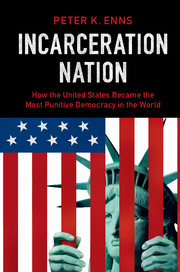5 - Democracy at work? Public opinion and mass incarceration
Published online by Cambridge University Press: 05 March 2016
Summary
It's clear — as we come together today — that too many Americans go to too many prisons for far too long, and for no truly good law enforcement reason.
Attorney General Eric H. Holder Jr. (August 12, 2013)The incarceration rate has gone up. Way up. And the consequences have been stark. As we saw in Chapter 1, between the early 1970s and 2000, the US incarceration rate increased by 400 percent. Although the United States comprises less than 5 percent of the world's population, almost 25 percent of the world's prison population now resides in US jails and prisons. We also saw that the growing incarceration rate spawned massive economic, social, and political costs, while offering limited and contingent benefits (at best) for crime reduction. Equally important, the social and political costs of mass incarceration have been disproportionately borne by racial minorities and those with the lowest income and education levels.
To gain a sense of the concentrated effects of the carceral state, Figure 5.1 reproduces an image generated by Eric Cadora and Laura Kurgan (2006).
This figure presents a white dot for each individual from Brooklyn, New York, who was admitted to prison in 2003. Before examining this figure, it is worth considering that in 2000, 29.1 percent of Brooklyn families with children were below the poverty line. The corresponding percentage in poverty for families with a female householder (no husband present) was 44.2 percent. Also of note, 36.4 percent of Brooklyn residents were black or African American and 19.8 percent of residents were Latino. These demographic characteristics matter because, as noted earlier, the rise of mass incarceration has occurred unevenly. Even after controlling for actual crime rates, racial minorities and individuals of low socioeconomic position are disproportionately imprisoned.
Figure 5.1 illustrates these patterns in striking fashion. Not only were Brooklyn residents sentenced to prison at a high rate in 2003, but even within Brooklyn, the patterns of incarceration are concentrated. The dots are clustered in neighborhoods like Bushwick, Bedford Stuyvesant, East New York, Brownsville, Crown Heights, and Flatbush, which also have the highest concentration of black residents and residents in poverty (Cadora, Gordon, and Swartz 2002).
- Type
- Chapter
- Information
- Incarceration NationHow the United States Became the Most Punitive Democracy in the World, pp. 100 - 126Publisher: Cambridge University PressPrint publication year: 2016



